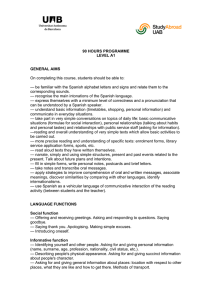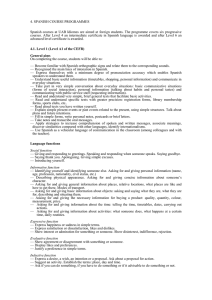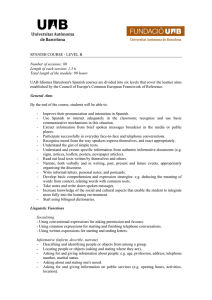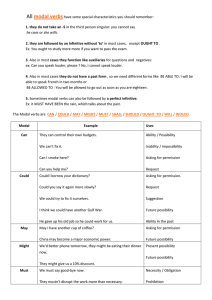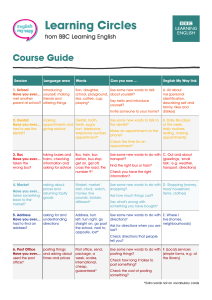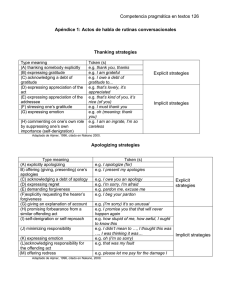Level A2 45 HOURS - Academic Studies Abroad
Anuncio
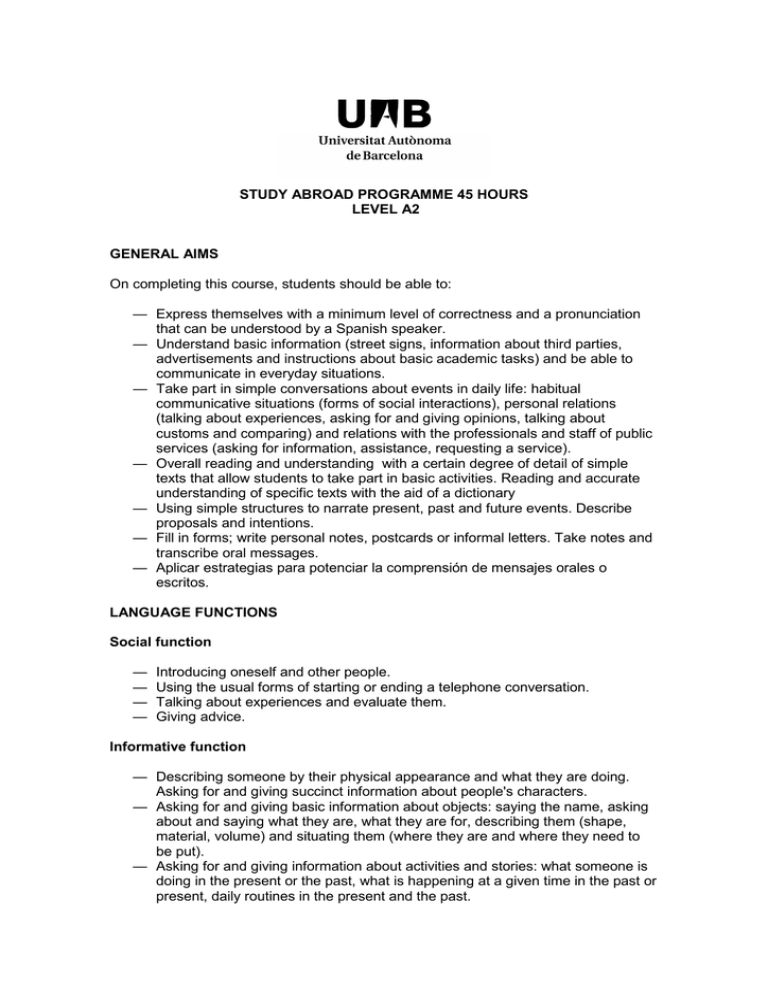
STUDY ABROAD PROGRAMME 45 HOURS LEVEL A2 GENERAL AIMS On completing this course, students should be able to: — Express themselves with a minimum level of correctness and a pronunciation that can be understood by a Spanish speaker. — Understand basic information (street signs, information about third parties, advertisements and instructions about basic academic tasks) and be able to communicate in everyday situations. — Take part in simple conversations about events in daily life: habitual communicative situations (forms of social interactions), personal relations (talking about experiences, asking for and giving opinions, talking about customs and comparing) and relations with the professionals and staff of public services (asking for information, assistance, requesting a service). — Overall reading and understanding with a certain degree of detail of simple texts that allow students to take part in basic activities. Reading and accurate understanding of specific texts with the aid of a dictionary — Using simple structures to narrate present, past and future events. Describe proposals and intentions. — Fill in forms; write personal notes, postcards or informal letters. Take notes and transcribe oral messages. — Aplicar estrategias para potenciar la comprensión de mensajes orales o escritos. LANGUAGE FUNCTIONS Social function — — — — Introducing oneself and other people. Using the usual forms of starting or ending a telephone conversation. Talking about experiences and evaluate them. Giving advice. Informative function — Describing someone by their physical appearance and what they are doing. Asking for and giving succinct information about people's characters. — Asking for and giving basic information about objects: saying the name, asking about and saying what they are, what they are for, describing them (shape, material, volume) and situating them (where they are and where they need to be put). — Asking for and giving information about activities and stories: what someone is doing in the present or the past, what is happening at a given time in the past or present, daily routines in the present and the past. — Asking for and giving information about someone's state of health or their mood: asking and telling how you feel, where it hurts, describing symptoms. Expressive function — Expressing satisfaction or dissatisfaction, likes and dislikes, enthusiasm or boredom. — Expressing interest, admiration for something or someone. Expressing a lack of interest, indifference or rejection. — Expressing physical pain or relief. — Expressing fear, fright, unease. Expressing confidence and conviction. . Evaluative function — — — — — Expressing agreement or disagreement with someone or about something. Express tastes and preferences. Valuing and comparing. Asking for and giving opinions. Justifying an opinion, valuation or statement. Inductive function — Asking and giving permission to do something. — Expressing desires, wishes, intentions or proposals. Asking about a proposal for action. — Proposing an activity. Agreeing to the terms of a meeting: place, day and time. — Asking if something can be done, should be done or if it is better not to do it. Meta-linguistic function — Asking a telling about understanding an expression. — Asking someone to repeat something, to talk louder or slower. — Asking for clarification about the meaning of a word or an expression. GRAMMATICAL CONTENT Determinants and Quantifiers — Male, female and neuter demonstratives. — Possessives as adjectives: (mi, tu, su, nuestro/a, vuestro/a, su, mis, tus, sus, nuestros/as, vuestros/as sus) y pronominal (mío, tuyo, suyo…). — Indefinite pronouns: algún, ningún, algo, nada, alguien, nadie. Nouns and adjectives — Gender and number. Irregular singular and plural agreements. Verbs — Regular and irregular reflective verbs. — Verbs with emphatic pronouns: interesar, parecer, encantar, doler (“A mí me duele la cabeza”). — Future expressions. Use of the present in future expressions (tomorrow, next week…). — Simple past tense: regular and irregular forms. — Indefinite past tense: most common regular and irregular verbs. (hablar, levantarse, llegar, ir, ser, venir,…). — Contrasting the simple past the the indefinite past tenses using the most frequent expressions of time (hoy, ayer, esta semana, la semana pasada…). — Expressions with estar + gerund: in present and imperfect tenses. Adverbs — Adverbs of state: bien, mal, regular, fatal… — Adverbs of time: ahora, después, luego, ya, todavía no… — Adverbs of comparison: más…que, menos…que, tan/ tanto…como Pronouns — Personal unstressed direct object pronouns: me, te, lo, la, nos, os, los, las. — Personal unstressed indirect object pronouns: me, te, se, le, nos, os, se, le. Combinations of direct and indirect pronouns. — Relative pronouns: que. Prepositions — Most common prepositions: a, en, por, para, de, hacia, con, sin… Conjunctions — Frequently used conjunctions: y, o, pero, porque. Conjunctions that change before a vowel: y/e, o/u. Interrogative particles — qué, cómo, quién, cuándo, por qué,… Vocabulary — Formation of words by derivation. Word families: plata/plateado. — Irregular comparatives: mayor, menor, mejor… GRADING SYSTEM Our grading system takes into consideration the student's progression through the course: continuous assessment (30%) - and if the student achieves the course objectives or not - final exam (70%). ● Continuous Assessment: Class work. Assignments. Tests. During the course some of the exercises will be rated: Reading comprehension, listening comprehension and written expression. Students will be tested twice during the course: prior to the mid-term and during the second part of the course. These tests will be conducted as class exercises and not as partial exams, that is with no prior notification. Professor’s Evaluation Evaluation of the learning progression, participation in class and attendance. By the middle of the course, there will be a mid-term report with information from the first part of the course. These reports will be delivered to students and will be discussed individually in personal tutorials that will take place during class hours. ● Exam and Certification The final exam consists of 5 sections. Students must complete at least 50% of each in order to pass. Writing Speaking Reading Comprehension Listening Comprehension Grammar and Vocabulary Total 15 points 15 points 15 points 15 points 10 points 70 points The result in the exam (70 points) combined with the continuous assessment (30 points) result in the following grading: Grading Fail Pass Good Excellent* 0 – 6,49 6,50 – 7,49 7,50 – 8,99 9,00 – 10,00 *Excellent is reserved to exceptional cases. Those students who achieve 6.50 or more will get the corresponding certificate of the level. TEACHING MATERIAL Textbook Jaime Corpas et al., Aula 2, Difusión. Recommended complementary reading To be decided. Grammar resources — — — — F. Castro, Uso de la gramática española (nivel elemental), Edelsa. F. Castro, Aprende gramática y vocabulario 1, SGEL. Rosario Alonso et. al., Gramática básica del español, Difusión M. Cortés, Gramática y recursos comunicativos 1 (A--A2), Santillana. Dictionaries — Diccionario de bolsillo del español actual, SGEL.

